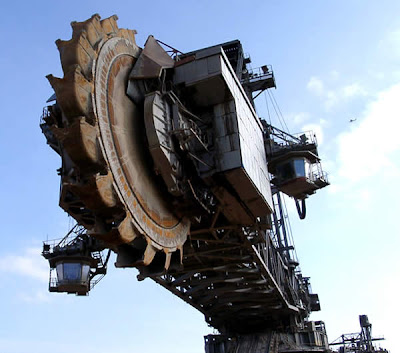The Bagger 288 (Excavator 288) is a bucket-wheel excavator, the largest in the world.
It was built in 1978 by German company Krupp for the job of removing overburden prior to coal mining in Hambach, Germany. When its construction was completed, Bagger 288 superseded NASA's Crawler-Transporter (that used to carry the Space Shuttle) as the largest tracked vehicle in the world.

By 2001, the excavator had completely exposed the coal source at the Hambach mine and was no longer needed there. It took 3 weeks to transport the machine 22 kilometers (14 miles) to the Garzweiler mine and the move cost around $8 million. Moving Bagger 288 in one piece was more economic than disassembling the excavator and moving it piece by piece.
BAGGER 288 FACTS:
- it took 5 years to design and manufacture it at a cost of $100 million
- the excavator is approximately 240 m long and 96 m high
- its weight is 45,500 tons
- it can excavate 240,000 tons of coal or 240,000 cubic meters of overburden daily
- the Bagger's operation requires 16.56 megawatts of externally supplied electricity
- it can travel 2-10 m (6-30 ft) per minute (0.1-0.6 km/h)
- the chassis of the main section is 46 meters (151 feet) wide and sits on 3 rows of 4 caterpillar track assemblies, each 3.8 m (12.5 feet) wide
- the excavating head itself is 21.6 m in diameter and has 18 buckets each holding 6.6 cubic meters of overburden.











It was built in 1978 by German company Krupp for the job of removing overburden prior to coal mining in Hambach, Germany. When its construction was completed, Bagger 288 superseded NASA's Crawler-Transporter (that used to carry the Space Shuttle) as the largest tracked vehicle in the world.

By 2001, the excavator had completely exposed the coal source at the Hambach mine and was no longer needed there. It took 3 weeks to transport the machine 22 kilometers (14 miles) to the Garzweiler mine and the move cost around $8 million. Moving Bagger 288 in one piece was more economic than disassembling the excavator and moving it piece by piece.
BAGGER 288 FACTS:
- it took 5 years to design and manufacture it at a cost of $100 million
- the excavator is approximately 240 m long and 96 m high
- its weight is 45,500 tons
- it can excavate 240,000 tons of coal or 240,000 cubic meters of overburden daily
- the Bagger's operation requires 16.56 megawatts of externally supplied electricity
- it can travel 2-10 m (6-30 ft) per minute (0.1-0.6 km/h)
- the chassis of the main section is 46 meters (151 feet) wide and sits on 3 rows of 4 caterpillar track assemblies, each 3.8 m (12.5 feet) wide
- the excavating head itself is 21.6 m in diameter and has 18 buckets each holding 6.6 cubic meters of overburden.

















